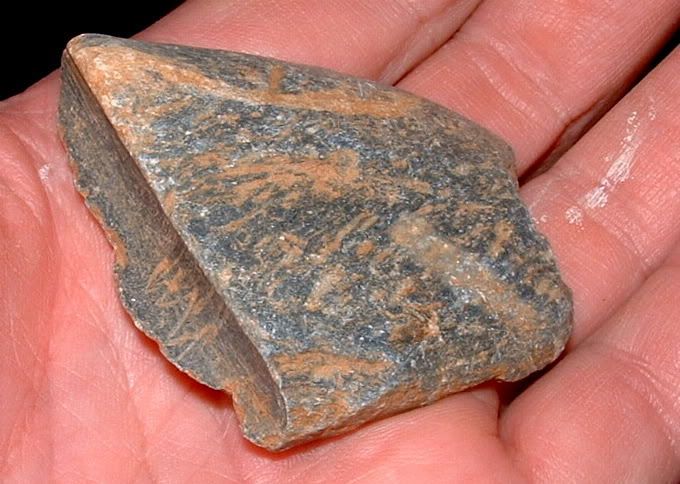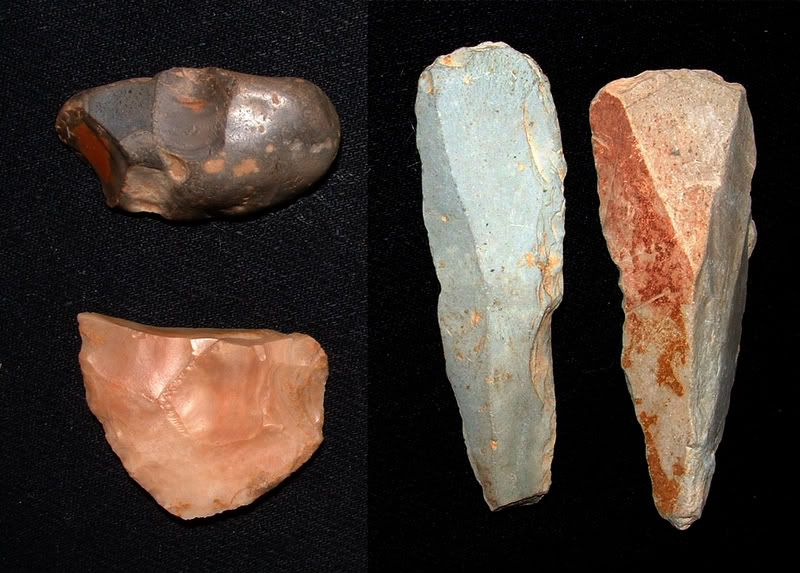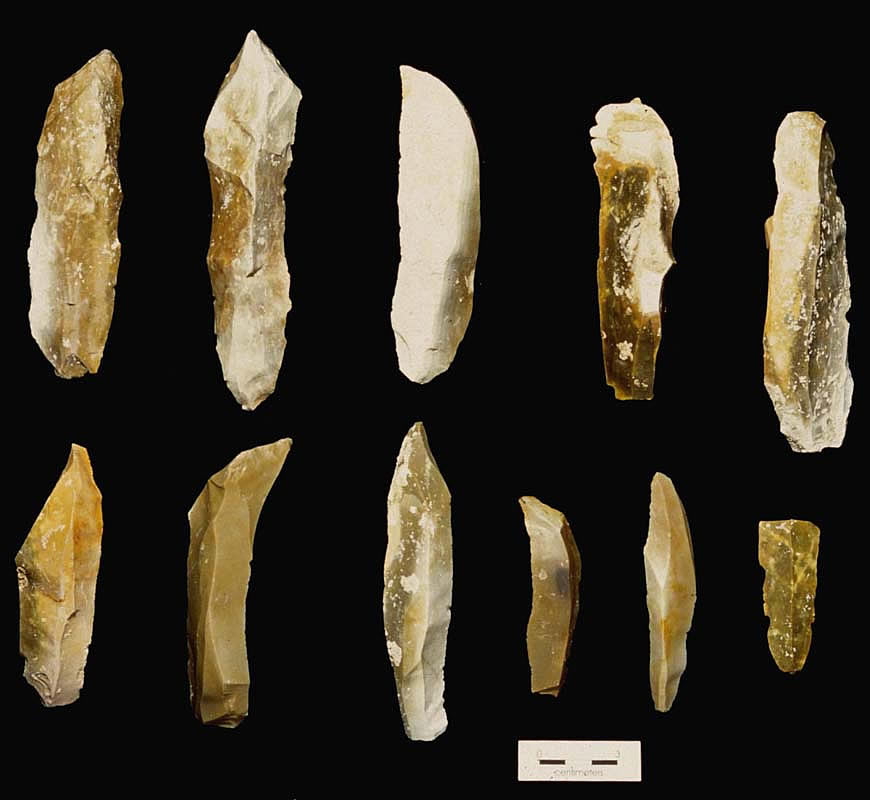NC artifacts
Moderators: MichelleH, Minimalist, JPeters
Hi. I'm unfamiliar with lithic artefacts not being able to tell spear from arrowheads. I saw the names above: Hardaway, Guilford, Kirks, Big Sandy. Are these official names or randomly chosen names? What criteria is used to date spear and arrowheads of various places of North America as in North Carolina? For instance, is there an online learning page someone could get an idea about how to date finds?
Thanks,
Thanks,
Marc Washington
-
Minimalist
- Forum Moderator
- Posts: 16044
- Joined: Mon Sep 26, 2005 1:09 pm
- Location: Arizona
Wait until Charlie gets back, Paul. He knows more about rocks than any man alive.
Something is wrong here. War, disease, death, destruction, hunger, filth, poverty, torture, crime, corruption, and the Ice Capades. Something is definitely wrong. This is not good work. If this is the best God can do, I am not impressed.
-- George Carlin
-- George Carlin
Now, Bob... no need to wait for Charlie! 
http://www.arch.dcr.state.nc.us/ncarch/ ... points.htm
Hi Paul,
Above is a link to the chart for NC Piedmont point types with dates.
As for the names of the types, they have been so designated by the
archaeolgists who excavated them and published the results of their
studies. FOr the sake of consistency and to facilitate discussion, the names are accepted.
The names usually come from the modern names of the areas where
they are found. Could be the property owner's name, a river, stream,
town, or other landmark.
If similar types are found later, even in another state, the names
are used again, indicating the shapes and methods of manufacture.
Many of the NC names were assigned by the "father" of NC archaeology,
Joffre Lanning Coe, who published "Formative Cultures of the NC Piedmont" in 1964. He was able to coordinate the stratigraphy from
four significant sites and thus definitively establish the sequence of these lithic cultures for a period of about 10,000 years.
Archaeologists think that the bow and arrow appeared here about 2000 years ago, gradually replacing the atl-atl (spear-thrower). Standard spears or lances were used before the atl-atl.
Here's another link to lots of pictures of NC points:
http://www.arch.dcr.state.nc.us/uwharrie/oliver25.html
You can google a lot of these things for more information. Try google
image search. It's great.
Hope this helps! Happy holidays.
Stan
http://www.arch.dcr.state.nc.us/ncarch/ ... points.htm
Hi Paul,
Above is a link to the chart for NC Piedmont point types with dates.
As for the names of the types, they have been so designated by the
archaeolgists who excavated them and published the results of their
studies. FOr the sake of consistency and to facilitate discussion, the names are accepted.
The names usually come from the modern names of the areas where
they are found. Could be the property owner's name, a river, stream,
town, or other landmark.
If similar types are found later, even in another state, the names
are used again, indicating the shapes and methods of manufacture.
Many of the NC names were assigned by the "father" of NC archaeology,
Joffre Lanning Coe, who published "Formative Cultures of the NC Piedmont" in 1964. He was able to coordinate the stratigraphy from
four significant sites and thus definitively establish the sequence of these lithic cultures for a period of about 10,000 years.
Archaeologists think that the bow and arrow appeared here about 2000 years ago, gradually replacing the atl-atl (spear-thrower). Standard spears or lances were used before the atl-atl.
Here's another link to lots of pictures of NC points:
http://www.arch.dcr.state.nc.us/uwharrie/oliver25.html
You can google a lot of these things for more information. Try google
image search. It's great.
Hope this helps! Happy holidays.
Stan
The deeper you go, the higher you fly.
-
Minimalist
- Forum Moderator
- Posts: 16044
- Joined: Mon Sep 26, 2005 1:09 pm
- Location: Arizona
But...but...Charlie's got PICTURES of rocks, Stan!
Something is wrong here. War, disease, death, destruction, hunger, filth, poverty, torture, crime, corruption, and the Ice Capades. Something is definitely wrong. This is not good work. If this is the best God can do, I am not impressed.
-- George Carlin
-- George Carlin



The first two pictures are of half an atl-atl weight, I believe. It is of steatite, and you can see that it has been battered a lot, being in the plow zone for hundreds of years. The hole bored through it must have left a very thin wall, but i don't think the maker would have spent hours drilling it without a sufficiently thick wall. So I am leaning in the direction that
since soapstone (steatite) is soft, it gradually eroded away after lying on the surface for a couple of thousand or more years. But notice that the broken edge of the borehole is not worn down very much. Its' a mystery.
What do you think, Charlie and Cognito?
The third picture shows a black flint nodule which I found here, but which
either came from west of the Appalachians or from England. I found it on the surface in Greensboro. It's almost two inches long. Is that large enough to make a flint for a flintlock?
The broken light colored fragment is also an imported flint piece.
On the right are two slate or sandstone tools, about 3.5 inches long.
An unusual color, and dry to the touch. It surprises me that anyone would make a tool out of such material, which is soft and can't hold a sharp edge. A matter of convenience, I suppose.
The deeper you go, the higher you fly.
- Charlie Hatchett
- Posts: 2274
- Joined: Wed May 17, 2006 10:58 pm
- Location: Austin, Texas
- Contact:
Hey, Stan.
Merry Christmas to you, Bro. I see what you’re saying about the thin walled,
uneroded drill hole, and apparently (erosion?) smoothed body. You think the body’s
polished/ ground? No telling what the maker intended? The last two pieces
look like blades, but then you say they’re soft material. Maybe
for grinding/ polishing in tight quarters? Grinding corner notches, etc...?
Any idea how old they are?
Merry Christmas to you, Bro. I see what you’re saying about the thin walled,
uneroded drill hole, and apparently (erosion?) smoothed body. You think the body’s
polished/ ground? No telling what the maker intended? The last two pieces
look like blades, but then you say they’re soft material. Maybe
for grinding/ polishing in tight quarters? Grinding corner notches, etc...?
Any idea how old they are?
Charlie Hatchett
PreClovis Artifacts from Central Texas
www.preclovis.com
http://forum.preclovis.com
PreClovis Artifacts from Central Texas
www.preclovis.com
http://forum.preclovis.com
Yes, Charlie, I'm pretty sure the atlatlweight is ground.
Soapstone is pretty soft. Maybe the hole was a bit big for the
piece to start out with, then it broke in use. Or, maybe, several
thousand years later, a tractor ran over it and broke it in two.
Not sure about the age of the light blue pieces. The only types we have
here with a rounded butt are "guilford" types, approximately 4000 BC.
I take it to be some sort of knife or hand tool, since there is no provision
for hafting.
Soapstone is pretty soft. Maybe the hole was a bit big for the
piece to start out with, then it broke in use. Or, maybe, several
thousand years later, a tractor ran over it and broke it in two.
Not sure about the age of the light blue pieces. The only types we have
here with a rounded butt are "guilford" types, approximately 4000 BC.
I take it to be some sort of knife or hand tool, since there is no provision
for hafting.
The deeper you go, the higher you fly.
- Charlie Hatchett
- Posts: 2274
- Joined: Wed May 17, 2006 10:58 pm
- Location: Austin, Texas
- Contact:
The last two pieces look similar to Clovis blades:Yes, Charlie, I'm pretty sure the atlatlweight is ground.
Soapstone is pretty soft. Maybe the hole was a bit big for the
piece to start out with, then it broke in use. Or, maybe, several
thousand years later, a tractor ran over it and broke it in two.
Not sure about the age of the light blue pieces. The only types we have
here with a rounded butt are "guilford" types, approximately 4000 BC.
I take it to be some sort of knife or hand tool, since there is no provision
for hafting.

Strange material, though.
Nice photos, Stan.
Charlie Hatchett
PreClovis Artifacts from Central Texas
www.preclovis.com
http://forum.preclovis.com
PreClovis Artifacts from Central Texas
www.preclovis.com
http://forum.preclovis.com
Charlie, glad you like the picture. I have enjoyed yours, too.
I have a couple pieces very similar to the lower row on
your pic of clovis blades. But I don't think mine aren't that old, since they were found in the plow zone with all the other stuff.
Seems that the method of quickly making a good sharp edge like
a razor was retained for a long time.
The lithic cultures here in NC, and probably elsewhere, are identified
by the style of the projectile points and other implements that have similar shapes or flaking patterns.
But what about an occasional tool made with one or two whacks of
the hammerstone? They would not resemble the diagnostic types
of points, but would be generic to all cultures. Is that right?
I have a couple pieces very similar to the lower row on
your pic of clovis blades. But I don't think mine aren't that old, since they were found in the plow zone with all the other stuff.
Seems that the method of quickly making a good sharp edge like
a razor was retained for a long time.
The lithic cultures here in NC, and probably elsewhere, are identified
by the style of the projectile points and other implements that have similar shapes or flaking patterns.
But what about an occasional tool made with one or two whacks of
the hammerstone? They would not resemble the diagnostic types
of points, but would be generic to all cultures. Is that right?
The deeper you go, the higher you fly.
- Charlie Hatchett
- Posts: 2274
- Joined: Wed May 17, 2006 10:58 pm
- Location: Austin, Texas
- Contact:
I think your right, Stan.But what about an occasional tool made with one or two whacks of
the hammerstone? They would not resemble the diagnostic types
of points, but would be generic to all cultures. Is that right?
Expedient tools were used in all cultures, even ours (a little bailing wire and pliers in our day)...
Charlie Hatchett
PreClovis Artifacts from Central Texas
www.preclovis.com
http://forum.preclovis.com
PreClovis Artifacts from Central Texas
www.preclovis.com
http://forum.preclovis.com
Rocks
Stan, that light flint piece really looks like a paleo scraper with the blunt side for the index finger and the bulb depression for the thumb. Looks like the cutting edge has been worked on the bottom. Is it very sharp? (Don't cut yourself answering that, OK?) 
Natural selection favors the paranoid
Flint
Stan, the material will be resistant to weathering since flint is value 7 on the Mohs hardness scale.Cognito, that piece is half of the original tool...
I posted it because the material is unusual around here.
But thanks for the reference, and the observations.
I don't know how it survived so long without weathering...
looks like it was made yesterday.
http://www.stoneageindustries.com/mohs_ ... dness.html
It looks like there is pressure flaking on the lower portion of the item (where the "V" shape is). Is that right? Is there pressure flaking on one side or both? Thanks.
Natural selection favors the paranoid